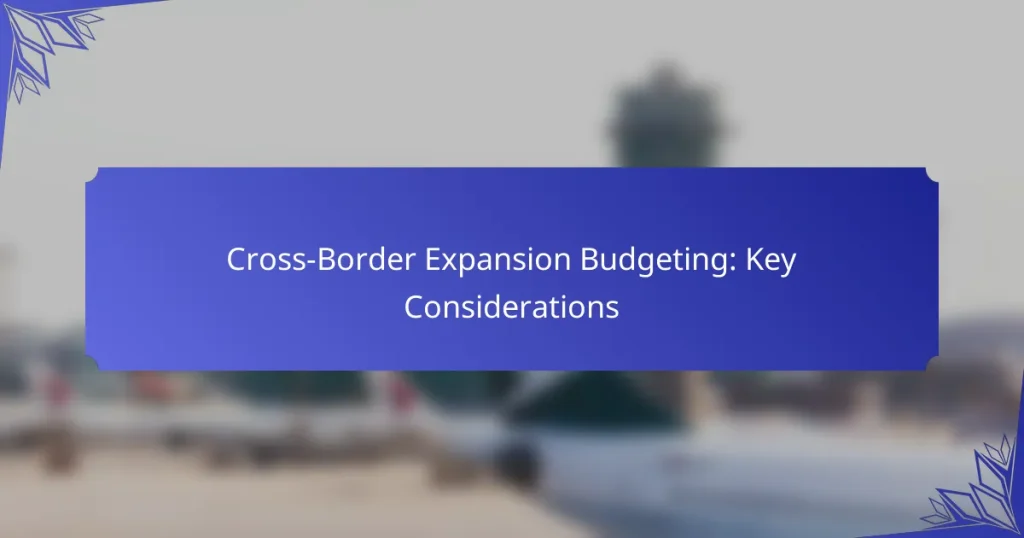Cross-border expansion budgeting is a critical process that requires a thorough understanding of the costs and risks associated with entering new markets. Businesses must carefully estimate market entry expenses, including regulatory fees and operational costs, while ensuring compliance with local regulations. Effective resource allocation and risk management are essential to avoid unexpected financial challenges and enhance profitability in international operations.

What Are the Key Considerations for Cross-Border Expansion Budgeting?
Key considerations for cross-border expansion budgeting include understanding the various costs associated with entering a new market, ensuring compliance with local regulations, and managing financial risks. Each aspect requires careful planning to allocate resources effectively and avoid unexpected expenses.
Market Research Costs
Market research costs are essential for understanding the target audience, competition, and market dynamics in a new country. Businesses should budget for surveys, focus groups, and data analysis, which can range from a few thousand to tens of thousands of dollars depending on the depth of research required.
Investing in local expertise can enhance the quality of insights gained. Consider hiring local consultants or agencies familiar with the market to ensure accurate data collection and interpretation.
Regulatory Compliance Expenses
Regulatory compliance expenses involve costs related to adhering to local laws, including permits, licenses, and legal consultations. These costs can vary significantly by country and industry, so it’s crucial to research specific requirements early in the budgeting process.
Failure to comply with regulations can lead to fines or operational delays, making it vital to allocate sufficient resources for legal advice and compliance measures. Engaging local legal experts can help navigate complex regulations effectively.
Operational Setup Investments
Operational setup investments cover the costs of establishing a physical presence, such as leasing office space, purchasing equipment, and hiring staff. These expenses can be substantial, often requiring a budget in the low to mid six figures, depending on the scale of operations.
Consider phased investments to minimize upfront costs. Start with a smaller footprint and scale operations based on market response, which can help manage financial risk while testing the waters in the new market.
Currency Exchange Risks
Currency exchange risks arise from fluctuations in exchange rates, which can impact profitability when conducting cross-border transactions. Businesses should consider hedging strategies to mitigate these risks, such as forward contracts or options.
Regularly monitoring exchange rates and understanding the economic conditions of the target country can help in making informed decisions regarding pricing and budgeting. Establishing a currency risk management policy is advisable for long-term stability.
Local Marketing Budgets
Local marketing budgets are crucial for effectively promoting products or services in a new market. This includes costs for advertising, public relations, and promotional events tailored to local preferences, which can vary widely based on the market size and competition.
Allocate a percentage of expected revenue for marketing efforts, typically ranging from 5% to 15%. Engaging local marketing experts can enhance campaign effectiveness and ensure cultural relevance, helping to build brand awareness and customer loyalty.

How to Estimate Market Entry Costs?
Estimating market entry costs involves identifying and calculating all expenses associated with launching operations in a new market. Key factors include regulatory fees, operational expenses, marketing costs, and potential logistical challenges.
Cost Breakdown Methodology
The cost breakdown methodology involves categorizing all potential expenses into distinct groups to create a comprehensive budget. Common categories include legal fees, market research, staffing, and infrastructure costs. For instance, legal fees may range from a few thousand to tens of thousands of dollars, depending on the complexity of local regulations.
To effectively implement this methodology, create a detailed list of all anticipated costs, and assign estimated values to each category. This practice helps in identifying areas where costs can be minimized or where additional resources may be necessary.
Benchmarking Against Competitors
Benchmarking against competitors involves analyzing the market entry costs incurred by similar businesses in your target market. This comparison can provide valuable insights into typical expenses and help set realistic budget expectations. For example, if competitors report marketing costs of around 20% of their total budget, you can use this as a guideline for your own planning.
To conduct effective benchmarking, gather data through industry reports, market studies, or networking with other businesses. Understanding competitor strategies can also reveal potential pitfalls and opportunities for differentiation.
Utilizing Financial Modelling Tools
Financial modelling tools can assist in estimating market entry costs by simulating various scenarios and their financial implications. These tools allow businesses to input different variables, such as pricing strategies and market conditions, to forecast potential outcomes. Popular tools include Excel-based models and specialized software that offer templates for market analysis.
When using financial modelling, ensure that your assumptions are realistic and based on credible data. Regularly update your model as new information becomes available to maintain accuracy and relevance in your budgeting process.

What Are the Risks Involved in Cross-Border Budgeting?
Cross-border budgeting involves various risks that can significantly impact financial planning and resource allocation. Understanding these risks is crucial for businesses aiming to expand internationally, as they can affect profitability and operational efficiency.
Political and Economic Instability
Political and economic instability can pose significant risks to cross-border budgeting. Changes in government policies, civil unrest, or economic downturns can lead to unpredictable costs and affect the overall feasibility of operations in a foreign market.
For example, a sudden shift in trade regulations or tariffs can increase expenses unexpectedly. Companies should conduct thorough political risk assessments and consider establishing contingency plans to mitigate potential impacts.
Unexpected Tax Liabilities
Unexpected tax liabilities can arise from differing tax laws and regulations in foreign countries. Businesses may face additional taxes that were not anticipated during the budgeting process, which can erode profit margins.
To minimize this risk, it’s essential to engage local tax experts who understand the nuances of the tax system in the target country. Regularly reviewing tax obligations and maintaining compliance can help avoid costly penalties.
Supply Chain Disruptions
Supply chain disruptions are a common risk in cross-border operations, often caused by geopolitical tensions, natural disasters, or logistical challenges. These disruptions can lead to delays and increased costs, impacting the overall budget.
To address this, companies should diversify their suppliers and logistics partners. Implementing robust supply chain management practices and maintaining buffer stock can also help mitigate the effects of potential disruptions.

How to Create a Cross-Border Expansion Budget?
Creating a cross-border expansion budget involves assessing various costs and financial considerations unique to international markets. This budget should account for operational expenses, regulatory fees, and market entry strategies to ensure a successful expansion.
Step-by-Step Budgeting Process
The budgeting process for cross-border expansion typically starts with thorough market research to identify potential costs. Key expenses may include legal fees, taxes, and logistics, which can vary significantly between countries.
Next, outline a detailed budget that includes fixed and variable costs. Fixed costs might involve office space and employee salaries, while variable costs could encompass marketing and supply chain expenses. A well-structured budget helps in tracking and adjusting expenditures as needed.
Finally, regularly review and adjust the budget based on actual spending and market conditions. This iterative approach allows businesses to stay agile and responsive to changes in the international landscape.
Incorporating Contingency Funds
Including contingency funds in your cross-border expansion budget is crucial for managing unexpected costs. A common guideline is to allocate around 10-20% of your total budget for contingencies, depending on the market’s volatility.
These funds can cover unforeseen expenses such as currency fluctuations, regulatory changes, or unexpected operational challenges. Having a financial buffer ensures that your expansion efforts can continue smoothly, even when surprises arise.
Engaging Local Financial Advisors
Engaging local financial advisors is essential for navigating the complexities of cross-border expansion. These professionals can provide insights into local tax laws, financial regulations, and market conditions that may impact your budget.
Local advisors can also assist in identifying potential risks and opportunities specific to the region. Their expertise can help you make informed decisions, ensuring that your budget aligns with local practices and expectations.
When selecting a financial advisor, consider their experience in your target market and their understanding of your industry. A strong partnership can significantly enhance your budgeting process and overall success in the new market.

What Tools Can Help in Budgeting for Cross-Border Expansion?
Several tools can assist businesses in effectively budgeting for cross-border expansion. These tools help analyze financial data, assess market conditions, and manage currency risks, ensuring a comprehensive approach to international growth.
Financial Planning Software
Financial planning software is essential for creating accurate budgets and forecasts when expanding into new markets. These tools allow businesses to model various financial scenarios, helping to identify potential costs and revenues associated with international operations.
Popular options include QuickBooks, SAP, and Oracle Financial Services, which offer features like expense tracking, cash flow analysis, and reporting capabilities. When selecting software, consider integration with existing systems and user-friendliness to ensure smooth adoption.
Market Analysis Platforms
Market analysis platforms provide valuable insights into potential markets by offering data on consumer behavior, competitive landscape, and economic conditions. Tools like Statista, Euromonitor, and Nielsen can help businesses understand market demand and identify opportunities for growth.
Utilizing these platforms enables companies to make informed decisions about where to allocate resources and how to tailor their offerings to local preferences. Regularly reviewing market data is crucial for adapting strategies as conditions change.
Currency Risk Management Tools
Currency risk management tools are vital for mitigating the financial impact of exchange rate fluctuations during cross-border expansion. These tools help businesses hedge against potential losses by locking in exchange rates or using financial instruments like options and forwards.
Solutions such as OFX, CurrencyFair, and XE provide features for monitoring currency trends and executing transactions at favorable rates. Companies should assess their exposure to currency risk and choose tools that align with their specific needs and risk tolerance.

How to Monitor and Adjust the Budget Post-Expansion?
Monitoring and adjusting the budget after cross-border expansion is crucial for financial health. Regular assessments help identify variances and inform necessary adjustments to ensure alignment with strategic goals.
Regular Financial Reviews
Conducting regular financial reviews is essential for effective budget monitoring. These reviews should occur monthly or quarterly, depending on the scale of operations and market volatility. They allow businesses to compare actual spending against the budget and identify any discrepancies.
During these reviews, focus on key performance indicators (KPIs) such as revenue growth, cost variances, and profit margins. For instance, if expenses in a new market exceed projections by more than 10%, it may indicate the need for a strategic reassessment.
Establish a checklist for each review to streamline the process. Key items might include analyzing variances, reviewing cash flow forecasts, and assessing the impact of currency fluctuations on budget items. This structured approach ensures that no critical aspect is overlooked.


